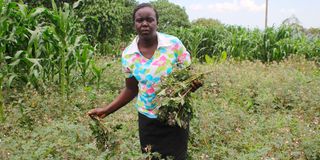Vine spinach: Nutritionally rich vegetable many ignore

Emily Kemboi, a farmer in Sugoi, Uasin Gishu County, harvests traditional vegetables in 2020.
Vine spinach (Basella sp.) is an important traditional leafy vegetable. It is an evergreen climbing plant with heart-shaped leaves. The vegetable is also known as Malabar spinach, climbing spinach, creeping spinach, Ceylon spinach or Indian spinach.
There are two species namely Basella alba which has green stems and dark green leaves and Basella rubra, which has red or purple stems and deep green leaves with pink or red veins. It is commonly known as “nderema” and belongs to the family basellaceae.
Vine spinach is rich in vitamins, minerals, proteins, carbohydrates and soluble fibre. It contains high amounts of vitamins A, B and C, calcium, iron, zinc, copper, magnesium, manganese, phosphorous and potassium. It has three times more vitamin C compared to spinach and 1.5 times more vitamin A than sukuma wiki (collard greens).
It is medicinal and has been used in the treatment of diarrhoea, dysentery, anaemia and cancer. Juice from the fruits is used as a dye, ink, cosmetics or food colour. Vine spinach is a source of income to farmers.
The vegetable is a short-lived perennial herb that can grow 4-8m long. It is commonly planted on hedges or staked or picked from the wild. The stem is succulent, smooth and twines around objects and it can be green or purple.

Vine spinach (nderema). Though rarely grown, vine spinach is highly nutritious.
Ecological requirements
Vine spinach does well in hot, humid and moist climates. It can do well under partial shade leading to increase in leaf size but it requires exposure to full sun for good yields. It can do well on a wide range of soils as long as they are fertile and rich in organic matter. Soil pH should be 6.5-7.0.
Land preparation
This should be done thoroughly to give the stubble enough time to rot. Organic matter should be added during land preparation.
Propagation
The vegetable is mainly propagated from vine cuttings. Seeds can also be used. Fully ripe seeds are collected, dried and stored for use the following season. For good germination, the seeds are soaked overnight a day before planting. Seeds take three weeks to germinate.
Weed control
Ensure that the field is kept weed-free throughout the entire growing season. Mulching can be done to keep the plant base moist and to smother weeds. Irrigation should be done to keep the soil moist
Training
Staking or trellising is used to support vine spinach due to its climbing growth habit. Alternatively, it can be grown along a fence.
Manure and fertiliser
Farmyard manure is applied before planting to ensure that the soil is rich in organic matter. Nitrogenous fertilisers can also be applied to maintain green foliage.
Harvesting is done depending on use. The leaves are crisp and juicy and when cooked, they have a mucilaginous texture. Leaves also have a high moisture content and should be cooked or taken to the market as soon as possible because they are highly perishable.
Health benefits of vine spinach
It regulates and controls blood pressure, maintains a healthy heart, reduces bad cholesterol and increases good cholesterol, lowers blood sugar and is good during pregnancy because it contains iron. Vine spinach contains fibre, which helps improve digestion and boosts detoxification.
Vine spinach also contains anti-oxidants that prevent cancer by neutralising free radicals which cause cancer. The anti-oxidants include beta-carotene, lutein and zeaxanthin. The anti-oxidants also prevent aging.
Vine spinach prevents anaemia as it contains iron, which is responsible for the formation of new blood cells.
It helps in development of healthy bones because of its calcium and magnesium content. It also contains vitamin C that helps boost immunity.
Carol Mutua, crop production specialist.




